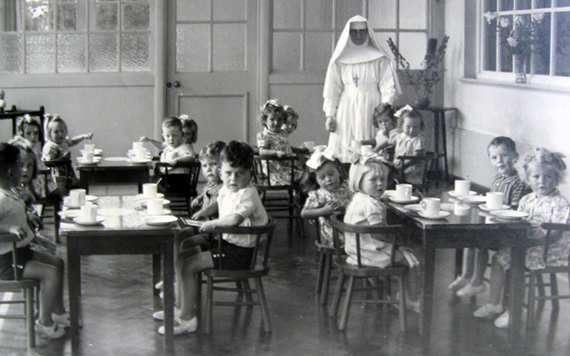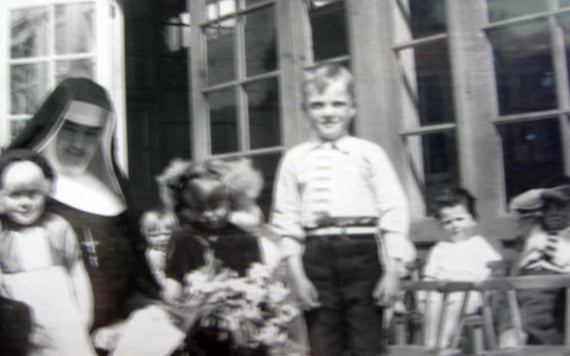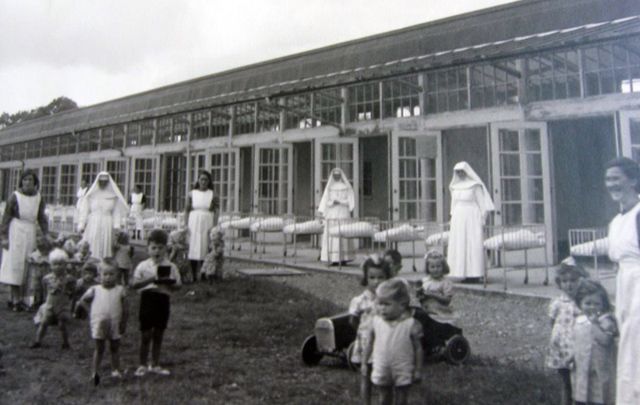The revelation last Friday by the commission investigating the Tuam mother and baby home scandal that infant skeletons had been found in underground chambers at the site has led to horrified headlines, not just at home but around the world.
That's not surprising. The story (not entirely accurate) that the remains of hundreds of children had been "dumped" in a "sewage pit" by the nuns who ran the home over several decades was shocking enough to get international coverage. On Friday night I saw it on the BBC, Sky News, and American and European TV channels.
Several elements gave the story a high level of interest. Although almost medieval in its horror, this had taken place in the recent past, in the four decades between the 1920s and 1960s. The unfortunate babies and children were in the home because they were illegitimate, born to unmarried young mothers. Above all, the home was run by nuns.

A nun and young children pose for a photo at a Mother and Baby Home.
And it is true that the nuns have a lot to answer for. Last weekend there were calls for a criminal follow-up and prosecutions, although only two nuns who served in the Tuam home are still alive and they are in their 80s and may not have been directly involved. The Bon Secours order of nuns they belonged to who ran Tuam has shrunk to a handful of very elderly sisters.
But the idea that this scandal is all the fault of cruel and heartless nuns is a convenient way of dodging the wider truth. It wasn't just the nuns who were to blame. It was Irish society at the time.
What was happening in Tuam – and other mother and baby homes around Ireland – involved many people here at various levels of officialdom. The clergy, local council officers who inspected the homes, the police who returned runaway girls to the homes, and politicians and civil servants who approved funding, were all active participants in the system.
Even the idea that the wider public here did not know what was going on is suspect. The church-ridden Irish society at the time may have turned away and pretended to know nothing. But even if nothing was said, many people knew.
In the Ireland of the time, being unmarried and pregnant was not only sinful but deeply shameful. Families who discovered their daughter was pregnant hid the shame by packing her off to a home like the one in Tuam and spreading the story that she had gone to a job in Dublin or London.
After the birth, many of these young women ended up in the notorious Magdalene laundries or emigrated, while the babies ended up in orphanages or were adopted (as you may know, an estimated 2,000 were sent to America). In many cases – probably the majority – the separation of mother and baby was forced. The heartbreak and suffering involved was enormous.
The mother and baby home in Tuam, Co. Galway, was not the only one, as we said, and it was far from being the biggest. And what was going on there was not an anomaly or an exception. It was the norm.
What has now been discovered in Tuam is likely to be just the beginning of a horrific saga. There has been no excavation yet in the grounds of bigger homes like St. Patrick's in Dublin, Bessborough in Cork, Castlepollard in Westmeath and several other major sites around the country. Thousands of babies and children – and some mothers – are believed to have been secretly buried in these places over the decades mentioned.
This unbelievable number has not been plucked from the air. Records of births and deaths at these homes were compiled and kept because the homes, although run by orders of nuns, were largely funded by the state and money was determined by the numbers. There were also inspections by state medical officials who must have been aware of what was happening, yet did little because not much could be done without the necessary funds.
The fact is that the mother and baby homes were seriously underfunded in the poverty-stricken, newly independent Ireland of the time. The babies and small children were miserable and malnourished, frequently cold, poorly clothed and as a result prone to sickness and disease. Medical training among the nuns was rudimentary since spiritual formation was seen as far more important.
This was also a time when infant mortality in general was far higher than it is today. The death rate among this young age group in Ireland at the time was around 10 percent. In the mother and baby homes the rate averaged 30 percent, a result of ignorance and neglect, with inadequately treated infections, fevers, pneumonia, stomach bugs, measles, etc.
Some homes were much worse than others. For example, in one mother and baby home in 1943 – ironically the same year that de Valera delivered his famous Patrick's Day radio address to the nation talking about comely maidens and cozy firesides – nearly 80 percent of the babies born there that year died.
In all of these homes when the babies died there was no money for normal funerals and burial; in many cases the mother was already gone and her family was not interested. So the dead infants were interred in mass graves on site.
The work of Catherine Corless brought to light 796 children's death certs relating to the home in Tuam. Here are all of their names #CBLive pic.twitter.com/oipboNTUNF
— RTÉ ClaireByrneLive (@ClaireByrneLive) March 6, 2017
There was another factor at play as well – the desire for secrecy and the compulsion to hide the reality away from the wider society.
In the Tuam case, disused underground chambers that had been part of a drainage system or possibly a former sewage system were used. As far as we know at this stage, the only reason this was done was to save the cost of digging graves and, of course, to keep things secret. It is likely that the underground drainage chambers had been disused and dry for years before being used to inter the infant bodies.
There is no reason to assume the bodies were treated with disrespect. To say the dead babies were "dumped" in a "sewage pit" or a "septic tank,” as many of the weekend reports did, implies a degree of callousness on the part of the nuns for which there is no evidence.
Nevertheless, as we said above, the nuns clearly bear a high degree of responsibility. But the important thing to remember in this shameful saga is that they were only one part of a wider system that involved Irish society as a whole. Holy Catholic Ireland of the time, in all its twisted hypocrisy, was the main culprit.

A nun sits with children inside a Mother and Baby Home.
This began with independence and the foundation of the new state, giving a special place and extraordinary power to the Catholic Church to shape the lives and thinking of the Irish people. Nor was it just de Valera, mentioned above, who kowtowed to the clergy. All the senior politicians in the state were at it in those early decades, right up to the 1970s, sinking to their knees to kiss the rings of the bishops and consulting with them on policy and legislation.
We had fought off British Rule only to willingly accept Rome Rule. And the consequences for Irish society were a suffocating atmosphere and appalling system designed to enforce the Catholic Church's obsession with "the evils of sex." This state and church sponsored regime, as we now know, produced all the horrors of the Magdalene laundries, mother and baby homes, orphanages and industrial schools.
The life-denying, guilt-inducing attitude to sex had a more general effect throughout Irish society, of course, warping personalities and blighting lives. Among the clergy themselves, the suppression of sexuality led to its release in widespread child abuse, as we now know.
The scandal of Tuam has emerged now mainly because of the work of one local woman who pursued the truth for years, aware of stories about the home and small skulls being found by children playing in the area. She found that even though records showed that 796 children had died in the home between the 1920s and 1960s, no one seemed to know where the bodies were. Her work and the publicity it generated led to the setting up of a commission of investigation two years ago which last week released its initial findings.

Historan Catherine Corless standing before the grotto in Tuam, Galway.
Where do we go from here? There have been calls for the entire site at Tuam to be excavated and all the bones found to be DNA tested to allow families who wish to do so to reclaim remains for burial. There have been demands that similar excavations should also take place at all former mother and baby homes around the country as well as at Magdalene laundries where secret burials also took place.
The last two mass graves to be discovered globally? Mosul,Iraq (ISIS)& Tuam,Ireland (Bon Secours Sisters).
— John O'Brennan (@JohnOBrennan2) March 7, 2017
Just think about that.#tuambabies pic.twitter.com/1Y6kkUtnJ6
Whether all this is feasible or even desirable at this stage is open to question, apart from the question of what it would cost. As usual here when a scandal like this emerges we react with outrage and extravagant corrective measures, as though somehow that can change or compensate for what happened in the past.
The truth is we cannot change the past. That was Irish society at the time.
We have to accept that and live with it. And make sure it never happens again.
Read more: Tuam “chamber of horrors” – babies starved, sold, experimented on




Comments